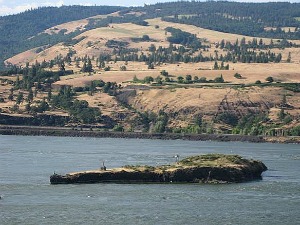Victor Trevitt, Oregon State Senator from 1866 to 1874, died of consumption in January 1883. Weeks after his death, his body was finally laid to rest on a flat-topped island of basalt in the middle of the Columbia River. Why did this Oregon pioneer choose such a unique spot for his final resting place?
According to local historian Alfred Powers, Trevitt told his friends, “I have but one desire after I die, to be laid away on Memaloose Island with the Indians.” Why? “They are more honest than whites . . . In the Resurrection, I will take my chances with the Indians.”
Memaloose Island got its name from the term “Memaloose illahee” which, roughly translated, means graveyard or tomb in the Chinook language.
For generations, the native tribes who inhabited the upper end of the Columbia Gorge used this barren, rocky island as a burial site. The dead were wrapped snugly in skins or blankets and placed inside wooden burial vaults-either on shelves or side by side on the floor of the tomb. The vaults, approximately 8 feet by 6 feet by 5 feet high, were constructed of wooden planks split from cedar or fir trees. Many were decorated with wood carvings or had designs painted on the doors and exterior walls.
There were 13 such sepulchers on the island when the Lewis and Clark Expedition passed through the area on April 13, 1806.
On the day of Trevitt’s funeral, a sizeable group of mourners was ferried across the water on a small passenger steamship. A Masonic funeral service was held and his casket was placed inside a stone vault about 8 feet square. The vault is crowned with a 13 foot tall granite obelisk clearly visible from the banks of the Columbia River. (see this striking close-up image of Trevitt’s Monument taken in the late 1800’s)
Ironically, Victor Trevitt’s tomb is the only grave remaining on Memaloose Island. The wooden burial vaults of the Chinook have long since vanished into history.
Memaloose Island and Trevitt’s Monument can be seen from the rest area adjacent to Memaloose State Park. It’s located about 80 miles due east from Portland, OR, on I-84. Watch for the exit ramps halfway between Mosier and The Dalles, OR.


Thanks for supporting outdoor theatre!
The drama and the social interactions of the 1800’s on the Columbia is forgotten until something like this story is written. My grandmother lived in the Dalles in 1903, where my father was born.She was a nineteen year old bride from Georgia, with one child and another on the way, and afraid of the native peoples around her, a fear she got over quickly as she received many kindnesses from the the Indian moms and grandmas who came to her aid during her time there.
I really enjoyed your story. The history and the dramatic scenery of the Columbia Gorge are both very interesting.